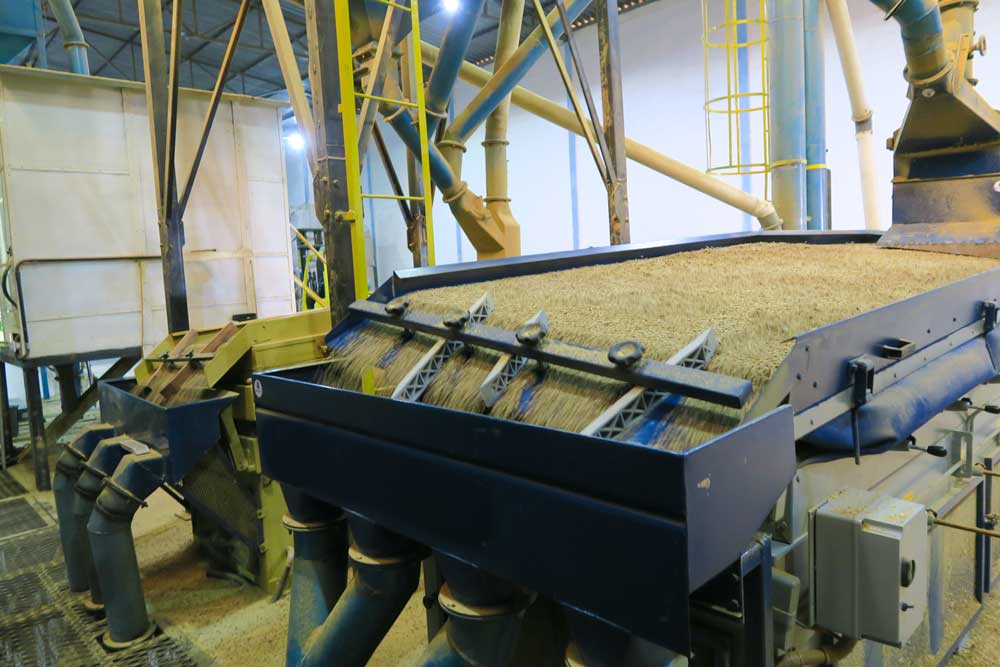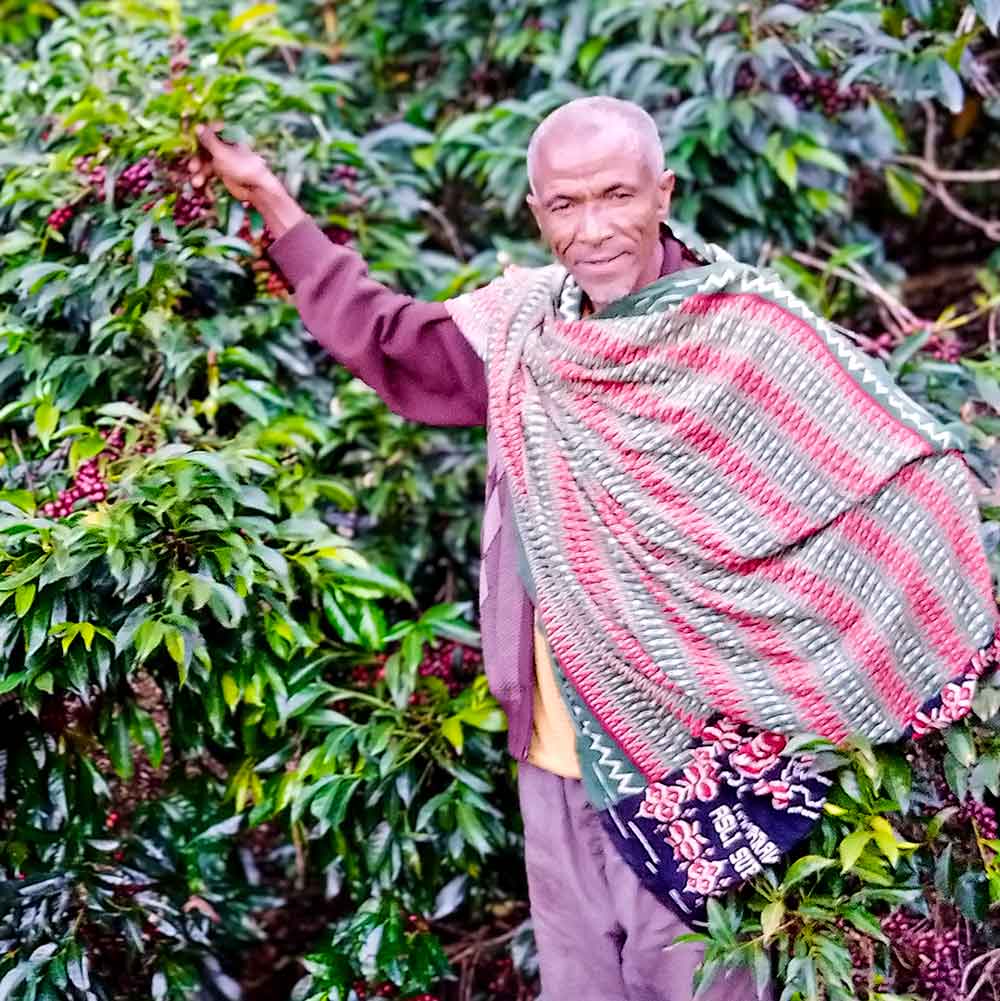

More amazing stuff to know.
About this coffee.
- Grower: Mr Ocholo Bedecho
- Origin: Ethiopia, Guji, Uraga
- Washing station: Arsosola
- Processing method: Natural
- Varietal: Arabica (Ethiopian Heirloom)
- Altitude: 2200 - 2300 MASL
Try our brew recipe. Or create your own
Recipe
Dose: 22g
Yield: 44g
Extraction ratio: 1 : 2
Extraction time: 28 - 32 seconds
Water temperature: 93.5oC
About the recipe
We used the Victoria Arduino Eagle One Prima and the Mythos MYG75 grinder to create this recipe for you. Try to replicate this recipe on your equipment or create your very own.
The dose is the amount of ground coffee that goes into the filter basket of your portafilter. Filter baskets come in different sizes. The size of your portafilter determines how much coffee (fill weight) it can hold. You don’t want to overfill or underfill the basket, as it will compromise the extraction.
The yield is how much delicious coffee you extract or, in order words, ends up in your cup.
And because you may have a different basket size than ours, you want to use a yield based on your dose and the given extraction ratio.
The extraction time tells you if the water has enough time to extract all the tasty goodness in the coffee. Adjusting your grind size will help you to achieve the suggested time in our recipe. You want to grind finer if you extract a yield in a shorter time. And grind coarser if you achieve the yield in a longer time than suggested.
Join our training courses.
Want to learn more about how to extract a tasty espresso? Join us for a fun and hands-on training course at our roastery.

Legend has it
Ever wondered how coffee was discovered?
Coffee is believed to have been discovered in Ethiopia in the 9th century, where legend has it that a humble goat herder named Kaldi wandering the lush highlands of Ethiopia, noticed his goats became more energetic after eating the berries of a certain plant. Intrigued, Kaldi decided to sample the berries himself and was amazed by their stimulating effect.
Word of this amazing discovery soon spread throughout the land, and Kaldi found himself sharing his findings with the local monastery. The abbot, curious about the goatherd's claims, decided to brew a drink with the berries and was astounded by the results. The drink kept him alert and focused through the long hours of evening prayer, and soon the entire monastery was buzzing with newfound energy. As news of the energizing berries continued to spread, it eventually reached the Arabian Peninsula and beyond, marking the beginning of a global trade that would shape the world as we know it today.
Thanks to Kaldi's curious mind and the power of the humble coffee bean, we can all enjoy the delicious and invigorating brew that has become a cornerstone of our daily lives.
We explain the supply chain of Ethiopian coffees.

Produced by Mr Ocholo Bedecho
This exceptional Ethiopian coffee comes from Mr. Ocholo Bedecho, a dedicated smallholder farmer in the Urga district of Guji Zone. His farm, located near the town of Haro Wachu, spans an impressive 8 hectares—one of the largest in the area. Talk about making the most of every acre!
While coffee is his mainstay, Mr. Ocholo also grows vegetables and Enset, ensuring his family has a steady supply of fresh, homegrown food. His two daughters and six sons are part of the team, each contributing to the farm’s day-to-day work.
Education is a top priority for Mr. Ocholo, and thanks to his coffee earnings, he’s able to send his children to school. After classes, they’re back on the farm, hands-on and learning the ropes of coffee cultivation alongside their father. For the Bedecho family, each harvest is more than just coffee; it’s a symbol of family, tradition, and a deep connection to the land.

The supply chain of Ethiopian coffees.
Private washing stations
Did you know that about 90% of Ethiopia's coffee comes from smallholder farmers? These hardworking folks deliver their freshly harvested cherries to local, privately owned washing stations. Now, picture this: washing stations are like coffee spas, where the beans either sunbathe on drying beds (for natural-processed coffees) or go through a relaxing wash and dry cycle (for washed coffees).
Many washing station owners also hold an export license, which allows them to sell their coffee directly on the international market—provided they have a contract, of course. Talk about taking their beans global! This particular coffee can be traced back to the Arsosola washing station. So, next time you sip your Ethiopian brew, remember the journey it took from a small farm to your cup. Cheers!

The supply chain of Ethiopian coffees.
Ethiopian Commodity Exchange 'ECX'
Washing stations without export licenses, or those with unsold coffees even if they do have a license, must sell their coffee through the Ethiopian Commodity Exchange (ECX) platform. The ECX classifies the coffee based on a basic potential cup score (Q1 for the highest quality, then Q2, Q3, etc.) and location (such as Guji, Yirgacheffe, Harrar, etc.). This classified coffee is then sold to licensed exporters through public daily auctions held in Addis Ababa.
Primary Cooperatives and large farms (over 30 hectares) are allowed to bypass the ECX and export their coffee directly. This system ensures that the best beans find their way to your cup, whether through auction or direct export. So, whether it's from a small washing station or a vast farm, Ethiopian coffee is all about quality and tradition.

The supply chain of Ethiopian coffees.
Dry-mill and exporter
The exporter in Ethiopia typically handles the dry-milling of the coffee, ensuring only the best beans make it to your cup. This process involves removing any unwanted materials like fibers, metals, stones, and sticks. Once the beans are free of debris, they are polished to perfection and sorted by size, density, and colour.
The result? Sorted, uniform coffee beans that are bagged and ready for shipment.

The natural (dry) process explained.
What is a natural processed coffee?
Since coffee beans grow inside a fruit (the coffee cherry), it takes multiple steps to separate the beans from their surrounding fruit flesh after harvest. In the coffee world, we call this the "processing method," and it has a huge effect on what ends up in your cup.
Sun-drying
Once the ripe coffee cherries have been picked, they are spread out to dry in the sun with the fruit flesh left intact around the coffee beans. This allows the beans inside the cherries to soak up all those delicious fruit flavors and sweetness.
Turning
The coffee cherries are regularly raked to ensure even air circulation and consistent drying. The fruit flesh dries around the coffee bean, and this process can take between 10 to 14 days, depending on the local climate, until a moisture level between 10 to 12% is reached.
Hulling
Finally, the coffee beans are "hulled" to remove the dried fruit flesh surrounding them. The beans are now ready to be sorted by size, density, and colour before being bagged and shipped.
It’s a little bit of sunshine and a whole lot of flavour packed into each bean. Enjoy!
Discovering the Guji Coffee Region in Ethiopia.
The Guji zone, once a subregion of Sidamo, has become a celebrated coffee region in its own right, known for unique flavour profiles distinct from neighbouring areas like Sidamo and Yirgacheffe. Guji boasts seven coffee-growing woredas: Odo Shakiso, Adola, Uraga, Hambela, Kercha, and Bule Hora.
Over the past six decades, Guji coffee has risen to prominence due to rapid commercial and cultural developments. This region is characterised by its lush, untouched forests and fertile soil, making it ideal for farming. Originally home to pastoralist Oromo people, most Guji residents are now farmers, with only a small percentage still herding cattle.
Guji coffee is renowned for its bright acidity, complex fruit notes, and lingering sweetness. The combination of fertile soil, meticulous farming practices, and an ideal climate contributes to its exceptional quality. Each cup of Guji coffee represents a rich history and innovative spirit, making it a delightful and flavourful experience.







